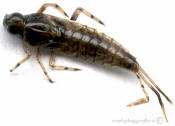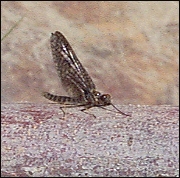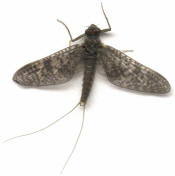|
|
|
 |
|
|
| |
|
The
spring time revival of aquatic insects on
Central Washington’s
infamous wild trout stream, the Yakima River, triggers the emotions of fly
anglers’ world wide as they seek out its waters each year. “What time
of year is best to fish the Yakima?” This question is uttered to me time
and time again by fly fishermen. It can be a difficult question to answer
because each month of the season is special in its own right. My
answer is usually based on the specific type of fishing each particular
angler wants to accomplish or enjoys. Nymph fishing with indicators,
swinging streamer patterns or pounding the grassy banks with big attractors
can fill in the gaps. However, the majority of fly fishermen prefer
the appeal of fishing dry flies to consistently feeding fish. If this
is the type of fishing you prefer, then the months of April and May are
right up your alley. |
|
| |
|
As the
month of March begins to wind down, hatches of Baetis (Blue Wing Olives) and
Skawlla Stoneflies have been going steadily since the last days of February.
Dry fly fishing begins early on this desert river and most anglers never
experience or overlook the importance of this first stonefly hatch.
Water conditions are generally low, given a normal winter and the Yakima
rainbows have been foraging since the last hatches of November.
Exciting, big, bug fishing can quickly chase away the cabin fever that has
set in over the long months of winter. |
| |
|
When
the month of April arrives, warming temperatures and mild spring days will
develop across the central basin. With increasing water temperatures,
the emergence of the Yakima’s most anticipated mayfly hatch of the season,
the
Rhithrogena Morrissoni or March Brown
Mayfly, will
begin to appear on the waters throughout the main stem of the
Yakima. This is the river’s most prolific, giant, mayfly emergence
that will occur each afternoon during the months of late March, April and
May. Some years, the upper regions of the river will continually
produce hatches of March Browns into the first parts of June. |
| |
|
As
the early stages of this emergence begin to take place, larger more dominate
trout will actively take naturals on the surface. Most likely, Baetis
Mayflies have been hatching for the past hour and attentions can quickly
turn from the smaller dun to its larger counterpart, the March Brown.
As minutes quickly pass and the hatch intensifies, the larger of the trout
will often disappear below the surface film and begin feeding on the
struggling emergers. Smaller, aggressive, trout will actively feed on
the naturals stranded on the river’s surface. During the peak of the
emergence, this mayfly will be littered across the water. A keen eye
in combination with an imitation that floats drag free as well as passes the
initial close up inspection of the trout will prove successful. Trout
generally won’t break their rhythm during this daily cycle of feeding. |
|
|
|
 |
 |
 |
|
Yakima River March Brown Nymph |
Yakima River March Brown Mayfly Dun |
Yakima River March Brown Mayfly Dun |
|
|
|
|
Excellent examples that imitate the natural mayfly in its adult dun stage
are the Para-Wulff Adam’s, Para-Pheasant Tail or a standard March Brown
pattern in sizes 12 and 14. The white, upright wings of the Para-Wulff
seem to present the appearance of a struggling insect and rainbows generally
will commit without refusal to this pattern. It also presents a highly
visible silhouette for the angler. If refusals do occur, a standard
March Brown imitation can be used. |
| |
|
Most
often times this is a high riding mayfly that uses it long arms to push its
self atop the water. It is slow to dry its colorful, mottled wing, so
a standard pattern that duplicates the natural will at times be more
productive. |
| |
|
The
B.H. F.B. Pheasant Tail, Bubble Back Emerger or soft hackle P.T. are
excellent patterns to replicate the sub-aquatic state of this insect.
Swinging soft hackle imitations under the first few inches of the surface
film can provide anglers with some exciting, wet, fly fishing. For
those unwilling or find it difficult to present a drag free drift to feeding
fish, the chances of action during the hatch are increased dramatically with
a soft hackle swing. |
| |
|
Activity of the hatch can last anywhere from 20 minutes to an hour and a
half. Once a daily appearance of March Browns becomes consistent, an
angler can set his watch to the time of their emergence. On most days
the hatch will begin sometime between 1:30 p.m and 2:00 p.m. Positioning
yourself on a section of river that is consistently producing a prolific
emergence each day can provide an angler with some exciting match the hatch
fishing. |
|
|
For tying directions see our
Fly Pattern Index! |
|
|
Name |
Order |
Family |
Genus |
Species |
Body Color |
Wing Color |
Emergence |
| |
|
March Brown |
EPHEMEROPTERA |
heptageniidie |
Rhithrogena |
Morrisoni |
Brown/Tan |
Brown Molted |
Afternoon |
|
|
|
|
|
|
Home
| Contact
Us
| River
Reports |
Fly
Fishing Adventures |